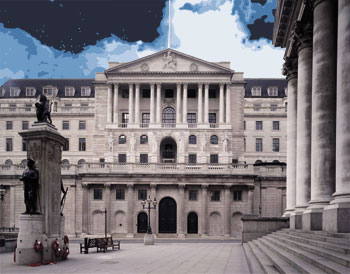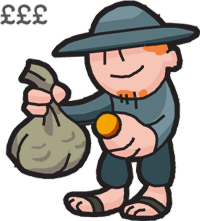 Pennies from Heaven!
Well not quite, but they had to come from somewhere. And China was the place! They were the first to make the simplest of metal coins around 700 B.C.
Before that, people were using everything from nails, shells and sword blades to stones, beads and even volcanic rock as units of ‘money’. Better than bartering cows, sheep and the odd banana, but still not terribly convenient. For instance, it was very difficult to divide objects like stones and shells, so giving change was a bit of a problem.
But it wasn’t until the wily old Lydians from Asia Minor came up with the monumentally clever idea of using precious metals to make coins that they became widely used. For the first time, every coin had a value – and that value was stamped on the coin. The Chinese had a word for this type of money: CASH!
Brilliant? Yeah. But no. But wait! Coins were OK to buy small items. But larger things needed sack-loads. Bit like buying a computer game and plonking down forty bags of 1 penny coins. So much copper and other precious metals would be needed that soon, it’d all run out.
 What to do? China had the answer - again: paper notes. Well, actually it was a 30 cm piece of deer skin, but the principle was the same. Anyway, back in 118 B.C. they didn’t mind. So the first ‘banknote’ was created worth 40,000 units of ‘cash’. What to do? China had the answer - again: paper notes. Well, actually it was a 30 cm piece of deer skin, but the principle was the same. Anyway, back in 118 B.C. they didn’t mind. So the first ‘banknote’ was created worth 40,000 units of ‘cash’.
Great! Well, not quite... It did take some 1,000 more years for banknotes to seriously take off, firstly in China - but that’s history for you! A bit later in Europe, people started using paper notes called ‘bills of exchange’ to deal with really large purchases. Each note contained the name of the traders and the value of what was being paid for.
 The first notes in the UK were issued in the 16th century by goldsmiths who were a bit like banks are today: trusted and secure. You’d leave your gold coins with the goldsmith and he’d give you a receipt; a ‘note’, representing the value of the coins you had deposited. The first notes in the UK were issued in the 16th century by goldsmiths who were a bit like banks are today: trusted and secure. You’d leave your gold coins with the goldsmith and he’d give you a receipt; a ‘note’, representing the value of the coins you had deposited.
Because everyone trusted the goldsmiths, their receipts were as good as the gold coins deposited in their safes, so people began using the receipts to pay for things.
 Banknotes and our whole system of using money, developed from this. It all revolved around trust, which continues to be central in the way we deal with money today. When we read the words, I PROMISE TO PAY THE BEARER… on each of our banknotes issued by the Bank of England and signed by the Chief Cashier, we know, absolutely, that we can trust the value of that note. Banknotes and our whole system of using money, developed from this. It all revolved around trust, which continues to be central in the way we deal with money today. When we read the words, I PROMISE TO PAY THE BEARER… on each of our banknotes issued by the Bank of England and signed by the Chief Cashier, we know, absolutely, that we can trust the value of that note.
www.bankofengland.co.uk/education
 back back
|






 What to do? China had the answer - again: paper notes. Well, actually it was a 30 cm piece of deer skin, but the principle was the same. Anyway, back in 118 B.C. they didn’t mind. So the first ‘banknote’ was created worth 40,000 units of ‘cash’.
What to do? China had the answer - again: paper notes. Well, actually it was a 30 cm piece of deer skin, but the principle was the same. Anyway, back in 118 B.C. they didn’t mind. So the first ‘banknote’ was created worth 40,000 units of ‘cash’. The first notes in the UK were issued in the 16th century by goldsmiths who were a bit like banks are today: trusted and secure. You’d leave your gold coins with the goldsmith and he’d give you a receipt; a ‘note’, representing the value of the coins you had deposited.
The first notes in the UK were issued in the 16th century by goldsmiths who were a bit like banks are today: trusted and secure. You’d leave your gold coins with the goldsmith and he’d give you a receipt; a ‘note’, representing the value of the coins you had deposited. Banknotes and our whole system of using money, developed from this. It all revolved around trust, which continues to be central in the way we deal with money today. When we read the words, I PROMISE TO PAY THE BEARER… on each of our banknotes issued by the Bank of England and signed by the Chief Cashier, we know, absolutely, that we can trust the value of that note.
Banknotes and our whole system of using money, developed from this. It all revolved around trust, which continues to be central in the way we deal with money today. When we read the words, I PROMISE TO PAY THE BEARER… on each of our banknotes issued by the Bank of England and signed by the Chief Cashier, we know, absolutely, that we can trust the value of that note.






